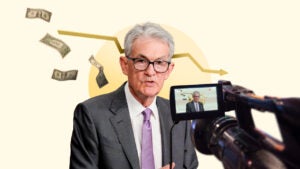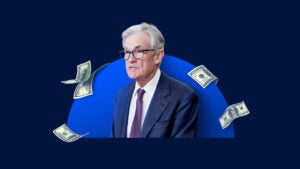Survey: Top economists say U.S. economy won’t be fully recovered from pandemic 12 months from now

More than a year after the coronavirus pandemic caused the most devastating recession since the Great Depression, the U.S. economy is expected to spend the next 12 months on an upward spiral, though it still won’t have gained back all of the ground that it lost by then, according to the nation’s top economists.
Experts polled for Bankrate’s Second-Quarter Economic Indicator survey see joblessness sinking to 4.49 percent a year from now, while U.S. employers are seen as adding an average of about 412,000 new positions each month over the next year. If those forecasts come to fruition, the U.S. economy will need just about 2.5 million more jobs to get back to where it was before the outbreak, while unemployment will be about 1 percentage point higher than its pre-recession low of 3.5 percent.
To be sure, those expectations would mark significant progress for the U.S. financial system, particularly after the outbreak cost 22.2 million jobs, put more than a quarter of the labor force on unemployment insurance (UI) and caused joblessness to surge to 14.8 percent. Half of experts surveyed, however, say an improving economy could risk generating more significant than expected inflation and interest rate increases by the Federal Reserve.
“Looking back on the past remarkable year, the healing of the economy has been quicker than might have been expected. This should translate to better prospects for household finances as more people are employed,” says Mark Hamrick, Bankrate senior economic analyst and Washington bureau chief. “This unique moment calls for some patience because of rising prices, as well as shortages of supplies and labor. Fortunately, there’s been ample supplies of COVID-19 vaccines to get us to the better place in the economy where we are today.”
Below are the findings from Bankrate’s survey, which polled 18 economists between June 3-13 on where they see unemployment, job creation, interest rates and the broader economy heading over the next 12 months.
Key takeaways:
- Americans should see an improving labor market, with economists expecting 4.49 percent unemployment a year from now and job growth averaging at about 412,000 over the next year.
- The Federal Reserve is mostly seen as leaving rates alone over the next year, though a growing number of economists (28 percent) are starting to pencil in a rate hike.
- Half of economists (50 percent) say inflation will likely be more significant in the intermediate term.
- The 10-year Treasury yield is predicted to rise to 2.06 percent a year from now.
- More than three-fifths (61 percent) say risks are tilted toward the upside for the U.S. economy over the next 12 months.
Economists expect continued improvement in the job market
Every economist surveyed for Bankrate’s second-quarter poll foresees unemployment falling from its current level of 5.8 percent a year from now, a good sign for the U.S. economy.
Economists, however, had different expectations for the pace of that improvement. Their average forecast called for an unemployment rate of 4.49 percent 12 months from now. Yet, expectations ranged from as low as 3.7 percent to as high as 5.6 percent.
For example, just 22 percent of experts surveyed (4 out of 18 polled experts) see unemployment holding above 5 percent a year from now. Meanwhile, 1 in 3 (or 33 percent) expect that joblessness will fall to 4 percent or lower.
Forecasts from Bankrate’s economists’ poll were slightly more pessimistic than that of Fed officials, with their median projections from June 2021 penciling in a jobless rate of 4.5 percent by the end of this year and then 3.8 percent unemployment by the end of 2022.
“Labor market frictions are likely to be more intense than usual due to the difficulties in matching millions of workers to available jobs,” says Scott Brown, chief economist at Raymond James. “Labor force participation may lag, partly reflecting early retirements of older workers.”
Yet, economists’ forecasts were more upbeat than in prior rounds, with results from the first quarter of 2021 calling for an unemployment rate of 5.1 percent a year from now.
Job growth to slow from current pace, with labor shortages front and center
When it comes to hiring, economists see employers adding about 412,000 new positions on average over the next 12 months. That might mean the current 12-month pace of job creation (992,000) is unsustainable, though it would still be a significant improvement from outlying months that were bleak, such as April, when employers only added 278,000 new positions.
The reason for the slowdown isn’t exactly what you’d expect. Experts say a labor shortage is partially to blame rather than a slowing U.S. economy.
Some workers might still be facing child care issues, which is keeping them on the sidelines. Meanwhile, enhanced unemployment benefits might be deterring others from going back to work, while others are still worried about catching the virus.
Eventually, those dynamics should fade as the pandemic moves increasingly into the rearview mirror, child care centers and schools reopen and ramped up jobless checks expire by September. Still, economists cite it as a significant barrier.
“The outlook for the job market depends on the willingness of workers to be vaccinated, the general opening of the economy and the adaptability of job seekers,” says Bernard Markstein, president and chief economist at Markstein Advisors. “Employment growth is slowed by the need to provide childcare at home, the need to care for and help elderly relatives, fear of contracting COVID-19 and a mismatch between jobseekers and the skills that employers need in new hires.”
Economists, however, are still more upbeat than in prior survey rounds, when experts forecasted average monthly job growth of 376,000 in the first quarter of 2021 and 321,000 in the fourth quarter of 2020.
Most economists expect the Fed to hold rates steady, though more are penciling in a rate hike
The Fed has made it clear that it wants to prioritize job creation and getting more Americans back to work before it tries to slow down the economy by hiking interest rates.
Powell in a press conference after the Fed’s June meeting stressed that it’s also hard to tell just how strong the job market is right now. Complaints of a labor shortage are picking up at a time when roughly 15 million Americans are still collecting UI, some 3.5 million individuals have dropped out of the labor force and another 7.5 million positions are still missing from the labor market.
While U.S. central bankers moved up their rate-hike timeline by penciling in at least two rate hikes in 2023, they mostly see rates still holding at rock-bottom levels through 2021 and 2022, according to their most recent projections.
Economists in Bankrate’s second-quarter poll echoed those expectations, with 72 percent of experts saying that they see no rate moves from the U.S. central bank over the next 12 months.
“The Federal Reserve is monitoring the pace of hiring as one of the indicators of the strength of the economic recovery,” says Odeta Kushi, deputy chief economist at First American Financial Corporation. “While the labor market recovery is likely to pick up steam in the months to come, as of April, the economy has only recovered 66 percent of the jobs lost at the start of the pandemic.”
Still, a growing number of economists are starting to recognize the likelihood that the Fed might have to shift course, with 28 percent in Bankrate’s poll predicting that the U.S. central bank will have to lift rates at some point over the next 12 months.
That’s the most of any survey period since the coronavirus pandemic slammed into the U.S. economy. Nearly 1 in 5 experts (or 19 percent) in the first quarter looked for a rate boost over the next year, compared to none at all in the fourth quarter of 2020.
Half of economists say inflation will be more significant than expected
Related to those rate hike expectations, half of economists are predicting that inflation will be more significant than expected. Just 38 percent expected inflation to be more significant than expected in Bankrate’s first-quarter poll, the first time the inflation question was asked.
“The Fed needs to give us a rate hike to calm nerves,” says Robert Brusca, chief economist at Fact and Opinion Economics. “If not now, when? The Fed should not replicate its bet from 2015 when it was confident it would hit its target and conducted policy as if it were right. The Fed needs to conduct policy realizing that it might not be right.”
Prices were always expected to rise this year as last year’s below-average readings drop out of the picture, supply chain bottlenecks get smoothed out and hordes of consumers leave their homes with stimulus cash after a year of lockdowns. Yet, inflation has risen much faster than Fed officials had even expected in their projections from March 2021 and December 2020.
Consumer prices in May soared by 4.9 percent from a year ago, the fastest pace since 2008. Another measure excluding more volatile food and energy categories rose by the most since 1992.
“Prices for many goods have ratcheted sharply higher in 2021,” said Mike Englund, chief economist at Action Economics. “We expect an updraft in inflation expectations through the year that may eventually prove problematic for the Fed, even though the climb may not be quantitatively large.”
About 39 percent of economists say inflation will prove to turn out as expected: faster than in previous years, but moderating eventually, reflecting temporary frictions.
“Inflation surges will be transitory, as consumers spend faster than producers can keep up,” says Yelena Maleyev, economist at Grant Thornton. “It is much harder to reopen an economy than it is to shut it down. Spending is already beginning to shift toward services rather than goods as reopenings ramp up and consumers catch up on missed appointments and gym, spa and restaurant outings.”
Just 11 percent (or 2 out of 18 economists surveyed) say that inflation will turn out to be less significant than expected. That’s largely in line with the prior survey period, when 14 percent said it would be less than expected.
“A number of industry-specific issues combined with post-pandemic supply and demand imbalances are boosting prices. However, they are likely to be transitory,” says Robert Hughes, senior research fellow at the American Institute for Economic Research. “As the issues are remedied, price increases are likely to slow. A 1970s-style inflationary spiral is extremely unlikely.”
The 10-year Treasury yield is predicted to rise to its highest level since July 2019
Reflecting higher inflation and a rebounding economy, economists see the 10-year Treasury yield rising to 2.06 percent over the next 12 months. That would be a significant uptick from the 1.46 percent where the key interest rate was trading at the end of the second-quarter survey period. If those forecasts prove to be true, that would also be the highest 10-year Treasury yield since July 2019.
Those forecasts matter for consumers, especially for homeowners and would-be homebuyers. The 10-year yield directly influences the 30-year, fixed-rate mortgage, meaning rising rates could cause home-buying costs to also increase. That’s already started to happen, though even as mortgage rates start to creep up, they’re still holding near record lows.
Experts say U.S. economy has more good going for it than bad
A confident sign for consumers, economists are upbeat about where the U.S. economy is heading over the next 12-18 months. More than three-fifths (or 61 percent) said the risks were tilted toward the upside, according to Bankrate’s second-quarter poll. That’s in line with what economists were projecting in the first quarter of 2021, when 62 percent said there was more to be optimistic than pessimistic about.
About 1 in 6 economists (or 17 percent) said risks were to the downside, while another 22 percent said risks were evenly balanced. All of that bodes well for consumers’ wallets, boosting economic confidence and job security.
“Congress is likely to pass more stimulus, banks have ample reserves to lend, and the Fed will maintain an easy monetary policy,” says Lynn Reaser, chief economist at Point Loma Nazarene University, on why she sees risks as tilted toward the upside.
What this means for you
If you’re worried about inflation, experts don’t recommend changing your investment strategy all that much, but be sure to maintain a diversified portfolio that includes an array of investment types, from real estate investment trusts (REITs) to dividend-paying stocks.
Inflation is almost like taking a pay cut. A good way to free up cash and budget for higher expenses might be refinancing your mortgage, which could shave hundreds of dollars off your monthly payment for the life of your loan.
Prioritize paying off high-cost credit card debt as interest rates remain low, and be wary about spending big on the vacations and events that you’ve been deprived of due to the recent pandemic shutdowns. Revise your budget to see how much you can afford spending on discretionary items once the lockdowns are fully lifted, and make sure that you have ample cash in a liquid and accessible savings account to cover any emergencies.
If you’re still struggling with joblessness, reach out to any lenders that you regularly pay a bill to for financial assistance, and utilize any federal forbearance programs if you’re needing to free up extra cash.
“As this crisis passes and the economy settles into a pattern of recovery, it remains key for individuals to make saving for emergencies a top financial priority,” Hamrick says. “Whether it is a hurricane, wildfire, power outage, or loss of job or income, different and new financial challenges lurk over the horizon. We just don’t know what we’ll be confronted with, or when, exactly. One way to be prepared is to save for that emergency, or proverbial rainy day.”
Methodology
The Second-Quarter 2021 Bankrate Economic Indicator Survey of economists was conducted June 3-13. Survey requests were emailed to economists nationwide, and responses were submitted voluntarily online. Responding were: Scott Anderson, executive vice president and chief economist, Bank of the West; Scott J. Brown, chief economist, Raymond James Financial; Ryan Sweet, director of real-time economics, Moody’s Analytics; John E. Silvia, president, Dynamic Economic Strategy; Gregory Daco, chief U.S. economist, Oxford Economics; Mike Fratantoni, chief economist, Mortgage Bankers Association; Yelena Maleyev, associate economist, Grant Thornton LLP; Lindsey Piegza, Ph.D., chief economist, Stifel; Lynn Reaser, chief economist, Point Loma Nazarene University; Joel L. Naroff, president, Naroff Economic Advisors; Robert A. Brusca, chief economist, FAO Economics; Robert Hughes, senior research fellow, American Institute for Economic Research (AIER); Odeta Kushi, deputy chief economist, First American Financial Corporation; Robert Frick, corporate economist, Navy Federal Credit Union; Bill Dunkelberg, chief economist, National Federation of Independent Business; Mike Englund, chief economist, Action Economics; Gus Faucher, chief economist, PNC Financial Services Group; and Bernard Markstein, president and chief economist of Markstein Advisors.
Why we ask for feedback Your feedback helps us improve our content and services. It takes less than a minute to complete.
Your responses are anonymous and will only be used for improving our website.






